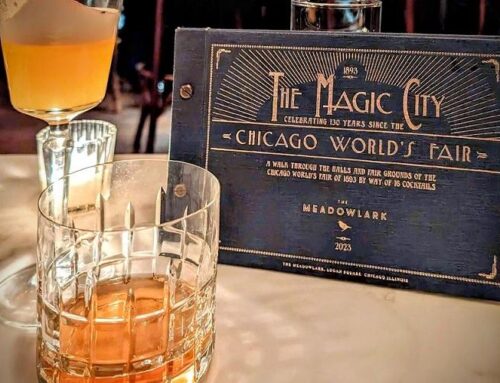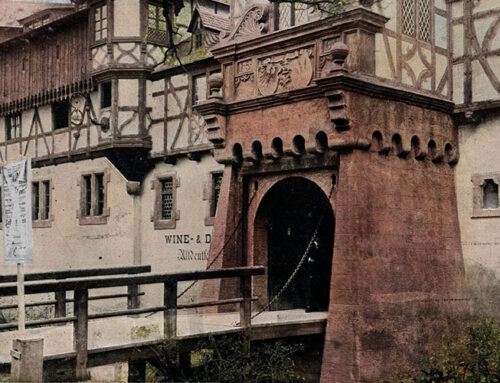The City of Chicago has announced the beginning of a process to review forty-one statues, monuments, murals, and plaques in the city that have been “identified for public discussion.” The list includes four statues that have a direct connection to the 1893 World’s Columbian Exposition in Chicago:
The Republic by Daniel Chester French
https://chicagomonuments.org/monuments/the-republic
This 1918 smaller replica of the original 1893 Statue of the Republic by Daniel Chester French is an enduring icon of the World’s Fair in Chicago. The “Golden Lady” stands in a traffic circle in Jackson Park close to where the Administration Building once stood.

The Republic by Daniel Chester French in Chicago’s Jackson Park. [Image by WorldsFairChicago1893.com.]
Bull and Indian Maiden by Daniel Chester French and Edward C. Potter
https://chicagomonuments.org/monuments/bull-and-indian-maiden
This 1908 bronze replica are reduced-size replicas of the original twelve-foot plaster casts that overlooked the Grand Basin in front of the Agricultural Building on the fairgrounds. This statue has resided in a garden behind the Garfield Park Conservatory since 1909 (except during a time when stolen) along with Potter and French’s other sculptural group of Ceres with a bull, also from the Fair.

Bull and Indian Maiden by Daniel Chester French and Edward C. Potter in Chicago’s Garfield Park. [Image by WorldsFairChicago1893.com.]
A Signal of Peace by Cyrus Edwin Dallin
https://chicagomonuments.org/monuments/a-signal-of-peace
Dallin’s bronze equestrian statue was exhibited in the Palace of Fine Arts at the 1893 World’s Fair. Art patron Lambert Tree purchased the sculpture for Chicago and had it installed in Lincoln Park, where it stands today just east of Lake Shore Drive at the north end of Diversey Harbor.

A Signal of Peace by Cyrus Edwin Dallin in Chicago’s Lincoln Park. [Image from the Chicago Park District.]
Christopher Columbus by Moses Ezekiel
https://chicagomonuments.org/monuments/christopher-columbus-monument
After reportedly being exhibited at the 1893 World’s Columbian Exposition, this statue was installed on the exterior of the Columbus Memorial Building in downtown Chicago. After that building was demolished in 1959, the statue went into storage for seven years before being installed in the “Columbus Plaza” of Arrigo Park on Chicago’s near West Side. Following vandalism in 2020, the statue was returned to storage.

Christopher Columbus statue and fountain by Moses Ezekiel, formerly in Chicago’s Arrigo Park [Image from waymarking.com]
Hard Truths
Public review of these and thirty-seven other municipal monuments follows an initial phase of the “Chicago Monuments Project,” established by City Hall after civil rights protests in the summer of 2020. During the uprisings, some activists attempted to topple a statue of Christopher Columbus in Grant Park and spray painted another Christopher Columbus in Arrigo Park. The city then (temporarily) removed both statues to protect the artwork and allow for more deliberate consideration of their future.
The Monuments Project advisory committee reviewed 500 public monuments and served as “a vehicle to address the hard truths of Chicago’s racial history, confront the ways in which that history has and has not been memorialized, and develop a framework for marking public space that elevates new ways to memorialize Chicago’s history more equitably and accurately.” They note the tradition of municipal monuments originating with the 1893 fair:
“Almost all the objects selected for consideration by the Chicago Monuments Project were created between 1893 and the late 1930s. Their origins can be traced to the World’s Columbian Exposition, which brought hundreds of sculptors, architects, and artisans to Chicago to design and construct an image of Chicago that aligned with the dominant culture of the day. In contrast to the harsh realities of living in a rapidly growing 19th-century industrial metropolis, the Exposition—often referred to as the “White City”—presented a highly idealized and orderly vision for Chicago in which traditional neo-classical architecture and sculpture was integrated into a well-manicured, natural setting. Constructed on a heroic scale and designed to overwhelm, the buildings and sculptures paid tribute to an idea of Progress, placing the western tradition, western Europe, and America at the apex of world civilization.
In this attempt to align itself with great European empires, past and present, the World’s Columbian Exposition set the terms for monuments for the next fifty years. Funded almost entirely by the wealthy, many of Chicago’s monuments were based on mythologies of the City’s founding that posed white explorers, missionaries, armed forces, and settlers against the indigenous tribes and nations of the region. These patrons were also responsible for idealized representations of American statesmen and military heroes.”
Statues on the current short list have been flagged by the committee (without further explanation for any specific monument) for:
- promoting narratives of white supremacy;
- presenting inaccurate and/or demeaning characterizations of American Indians;
- memorializing individuals with connections to racist acts, slavery, and genocide;
- presenting selective, over-simplified, one-sided views of history;
- not sufficiently including other stories, in particular those of women, people of color, and themes of labor, migration, and community building;
- and creating tension between people who see value in these artworks and those who do not.
Seeing this as “the start to a long overdue and necessary conversation,” the Committee has invited the public to share opinions on the role of these monuments in Chicago’s public spaces through April 1. To solicit such feedback, Committee members are hosting a series of online “Drop-in Conversations.” With (currently) only seven sessions limited to 20 participants, these events can allow for feedback from no more than 140 citizens in a city of 2.7 million people. Additional opportunities for public participation come in a series of webinars and panel discussions being planned, through the use of the social media hashtag #ChicagoMonuments, and through this online feedback form.
Chicago Mayor Lori Lightfoot has invited the city to confront the “hard truths of Chicago’s racial history.” One way to address our nation’s racism—past and present—is to engage deeply and critically with history. Such opportunities abound in the exploration of the people and events of the 1893 World’s Fair, its achievements and shortcomings. These four Columbian Exposition statues mean different things to different people and in different times. An open discussion of the history, creators, and original intent of these statues should inform future decisions about their placement and purpose in public spaces. Threatening this process, though, could be the substituting of one “selective, over-simplified, one-sided view of history” with another.






Leave A Comment